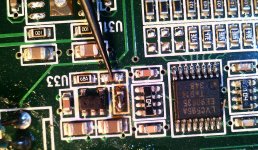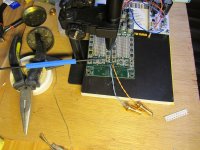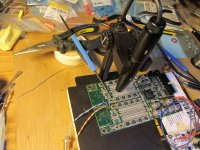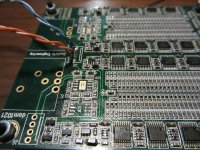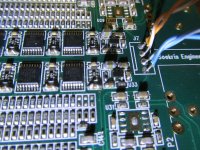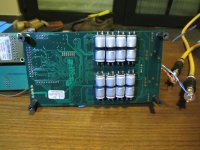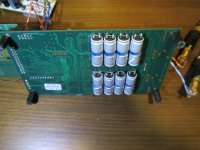I am not claiming to have experience with them since I read too many folks I trust (Allen Wright, most notably) who said they should be thrown away. I took much advice from the fellow in other areas that proved good.
I can certainly understand the hesitance to do the change again. At least the cap pads are bigger than the resistors.
I certainly am not belittling your experience. Those have to be better than a ceramic but there are (I HOPE) better choices.
Nonetheless I am impressed and jealous you got it done and it still works!!!
Take care,
I can certainly understand the hesitance to do the change again. At least the cap pads are bigger than the resistors.
I certainly am not belittling your experience. Those have to be better than a ceramic but there are (I HOPE) better choices.
Nonetheless I am impressed and jealous you got it done and it still works!!!
Take care,
Ok - thanks. I think that the output cap mod was the simplest, Just "warmed" away the smd caps, bent the legs on the new ones 90 deg to get little feet and soldered them in. And it will not be hard to get rid of them as now one can lift a leg at a time which is the problem with smd. I'm well familiar with the current status as I have had it for the last 2 week - time to test other 470pF.
//
//
Vref mods:
There are basically two way to good result:
1) The official modification with 0.1 ohms resistors and 47uF capacitors, all smd which can be a little tricky to solder.... You can afterwards add additional large capacitors, any type. But I admit that soldering 0603 smt parts are not that easy, so:
2) Just add large enough electrolytic capacitors without changing the smt parts, simulations show the best result with 3300 uf low impedance electrolytic on each rail, just your regular good caps, you don't want their impedance to get too low, 40 mOhm is perfect for the 3300 uF.
There are an additional internal power supply impedance in each LVC595 shift registers, I have measure 0.3 ohm. That mean that there is really no reason to get the vref impedance insanely low....
There are basically two way to good result:
1) The official modification with 0.1 ohms resistors and 47uF capacitors, all smd which can be a little tricky to solder.... You can afterwards add additional large capacitors, any type. But I admit that soldering 0603 smt parts are not that easy, so:
2) Just add large enough electrolytic capacitors without changing the smt parts, simulations show the best result with 3300 uf low impedance electrolytic on each rail, just your regular good caps, you don't want their impedance to get too low, 40 mOhm is perfect for the 3300 uF.
There are an additional internal power supply impedance in each LVC595 shift registers, I have measure 0.3 ohm. That mean that there is really no reason to get the vref impedance insanely low....
Last edited:
Do my 0 ohm hurt?
According to simulations, yes. In real life, probably not if you have large enough capacitance....
Just had a thought for those of us lacking nimble fingers:
How about using nickel resistance wire? 30 gauge would allow a "loop" which would be easier to tack on one end and then trim after soldering the other side.
Seems silly buying 100 feet of the stuff to get it but one would get countless attempts without ruining countless resistors.
Seems the stuff is used for those non-cigarette things.
At the rate I am going I could spend more than the spool on destroyed resistors.
How about using nickel resistance wire? 30 gauge would allow a "loop" which would be easier to tack on one end and then trim after soldering the other side.
Seems silly buying 100 feet of the stuff to get it but one would get countless attempts without ruining countless resistors.
Seems the stuff is used for those non-cigarette things.
At the rate I am going I could spend more than the spool on destroyed resistors.
Vref mods:
There are basically two way to good result:
1) The official modification with 0.1 ohms resistors and 47uF capacitors, all smd which can be a little tricky to solder.... You can afterwards add additional large capacitors, any type. But I admit that soldering 0603 smt parts are not that easy, so:
2) Just add large enough electrolytic capacitors without changing the smt parts, simulations show the best result with 3300 uf low impedance electrolytic on each rail, just your regular good caps, you don't want their impedance to get too low, 40 mOhm is perfect for the 3300 uF.
There are an additional internal power supply impedance in each LVC595 shift registers, I have measure 0.3 ohm. That mean that there is really no reason to get the vref impedance insanely low....
Soren, any chance you can provide any insight regarding the LowResMod and FrankenMod described by Paul in More Vref musings - Part 3 | moreDAMfilters and More Vref musings - Part 4 | moreDAMfilters
Polystyrene as other described very tough to use but used properly like tuned will give outstanding results but at the LPF position it will definitely be gritty not as gritty as tantalum but in between the tantalums and ceramics.
Vref mod I have added 56uf SEP capacitors but didnt like the sound as it was kind of adding someother problem but overall i felt the sound was bit smoother without the caps.
I think I should add more caps to the power supply or if soren comes with a Vreg for individual shift registers instead of just adding capacitor at the each psu pins of the shift registers.
Sonically I dont know if this can beat TotalDAC but like said listen to the tone its very important than just the details.
Like said sabastien might have golden ears who knows but yes what he observed was right as I felt something similar what he heard.
I think there is alot to do with the power supply than just adding some caps like independent v regulators for each shift registers would be my choice.
Vref mod I have added 56uf SEP capacitors but didnt like the sound as it was kind of adding someother problem but overall i felt the sound was bit smoother without the caps.
I think I should add more caps to the power supply or if soren comes with a Vreg for individual shift registers instead of just adding capacitor at the each psu pins of the shift registers.
Sonically I dont know if this can beat TotalDAC but like said listen to the tone its very important than just the details.
Like said sabastien might have golden ears who knows but yes what he observed was right as I felt something similar what he heard.
I think there is alot to do with the power supply than just adding some caps like independent v regulators for each shift registers would be my choice.
Could you please describe more in technical detail why such capacitor is unsuitable for this kind of duty?
//
//
Could you please describe more in technical detail why such capacitor is unsuitable for this kind of duty?
//
Im great fan of polystyrene caps I do use it in compensation caps they do excellent job but they are not as good sounding. The reveal the details but not good at right tonality. I dont want to redirect this thread as another caps thread.. 🙂
And neither do I but there is much more to making a good capacitor than using some specific material as a dielectric.
If that was the case all Polypropylene caps would sound as good as another and, I would think, everyone knows this is not the case.
There are excellent polystyrenes from RELCAP, I use them in my RIAA correction circuit.
There is a reason the STYROFLEX are so inexpensive.
If that was the case all Polypropylene caps would sound as good as another and, I would think, everyone knows this is not the case.
There are excellent polystyrenes from RELCAP, I use them in my RIAA correction circuit.
There is a reason the STYROFLEX are so inexpensive.
Inexpensive indeed. I got min from here. So you can try and report back ;-)
Polystyrene capacitor 470pF radial
//
Polystyrene capacitor 470pF radial
//
The problem with most styrenes is that you can just pull the pins right out. They aren't bonded to the foils. This is a potential route of oxygen into the plates which can lead to corrosion.
Of course, despite that, radio products still tend to use those styrenes in certain positions. So is it out of ignorance, are they just cost-effective, or do they still work really well despite the problems?
Of course, despite that, radio products still tend to use those styrenes in certain positions. So is it out of ignorance, are they just cost-effective, or do they still work really well despite the problems?
I doubt you find them in high reliability products. I suspect when one finds them in a product it is because they are cheap and work well enough to pass QC before being boxed up. CAVEAT EMPTOR
I thought these things ceased being manufactured long ago. Thought it was still surplus being sold.
Here is a link to a proven excellent PS cap - The RELCAP RT - Capacitor Sourcebook - AudioCap RT
I thought these things ceased being manufactured long ago. Thought it was still surplus being sold.
Here is a link to a proven excellent PS cap - The RELCAP RT - Capacitor Sourcebook - AudioCap RT
Here is a link to a proven excellent PS cap - The RELCAP RT - Capacitor Sourcebook - AudioCap RT
The shown capacitors start at 1nF, so the are too big for the output filter. From a physical point of view they are also quite large with long necessary leadouts, introducing a good amount of parasitic inductance. In the shown filter application it is probably best to use SMD caps, like soeren did for minimal parasitic effects. For example the Panasonic ECHU series with PPS dielectric is excellent here. If someone wants to use through hole caps, boxed versions like from WIMA are good from a physical point of view, due to their compact size with short leadouts.
Of course 600 volt capacitors are very reliable and fancy, but the huge body with large parasitic effects probably does more harm than good in these high-frequency filter application.
Finished soldering 🙂
All is soldered now: vref mod (0.01ohm series, +47uf, 0.68uf compensation) and a 680uf cap (x16) for each shift register. Also additional 390uf for the clock.
Without a PC microscope I would be unable to do it, also very practical to inspect the quality of the soldering afterwards.
Problem is also to have a steady hand, move 0.5mm and it's ruined.
One trick that I did was:
- position the component on the PCB
- put a forceps/pencil/long needle on top of the component and the other end of the forceps/pencil/needle not in your hands but a few cm higher on a object.
Now you have both hands free and the component will not move 🙂
I needed some extra weight on the long needle to have some pressure on the component, I used pliers for that (not on pictures).
DAC is playing fine now and much better, the Vref mod is a must !
Before the mods it was more 2D, with the mods the DAC has entered 3D 🙂
I think the R2R DAC can stay in my system now 🙂
Regards,
Danny
All is soldered now: vref mod (0.01ohm series, +47uf, 0.68uf compensation) and a 680uf cap (x16) for each shift register. Also additional 390uf for the clock.
Without a PC microscope I would be unable to do it, also very practical to inspect the quality of the soldering afterwards.
Problem is also to have a steady hand, move 0.5mm and it's ruined.
One trick that I did was:
- position the component on the PCB
- put a forceps/pencil/long needle on top of the component and the other end of the forceps/pencil/needle not in your hands but a few cm higher on a object.
Now you have both hands free and the component will not move 🙂
I needed some extra weight on the long needle to have some pressure on the component, I used pliers for that (not on pictures).
DAC is playing fine now and much better, the Vref mod is a must !
Before the mods it was more 2D, with the mods the DAC has entered 3D 🙂
I think the R2R DAC can stay in my system now 🙂
Regards,
Danny
Attachments
Last edited:
polystyrenes
REL also has the RTE series of caps, these are smaller boxed style parts, available from PcX. The PPS caps from Panasonic do sound pretty good when used for analog filter circuits as you have mentioned.
The shown capacitors start at 1nF, so the are too big for the output filter. From a physical point of view they are also quite large with long necessary leadouts, introducing a good amount of parasitic inductance. In the shown filter application it is probably best to use SMD caps, like soeren did for minimal parasitic effects. For example the Panasonic ECHU series with PPS dielectric is excellent here. If someone wants to use through hole caps, boxed versions like from WIMA are good from a physical point of view, due to their compact size with short leadouts.
Of course 600 volt capacitors are very reliable and fancy, but the huge body with large parasitic effects probably does more harm than good in these high-frequency filter application.
REL also has the RTE series of caps, these are smaller boxed style parts, available from PcX. The PPS caps from Panasonic do sound pretty good when used for analog filter circuits as you have mentioned.
More pics
Here some more pictures of the mods done.
The vias are a blessing to add extra caps, 26AWG wire fits nicely through the vias. Thanks glt !
For the moment playing with the latest filters from Paul, thanks Paul !
Congrats Soekris for the DAC, after the vref mods it's on the level I want it to be 🙂
Here some more pictures of the mods done.
The vias are a blessing to add extra caps, 26AWG wire fits nicely through the vias. Thanks glt !
For the moment playing with the latest filters from Paul, thanks Paul !
Congrats Soekris for the DAC, after the vref mods it's on the level I want it to be 🙂
Attachments
- Home
- Vendor's Bazaar
- Reference DAC Module - Discrete R-2R Sign Magnitude 24 bit 384 KHz
